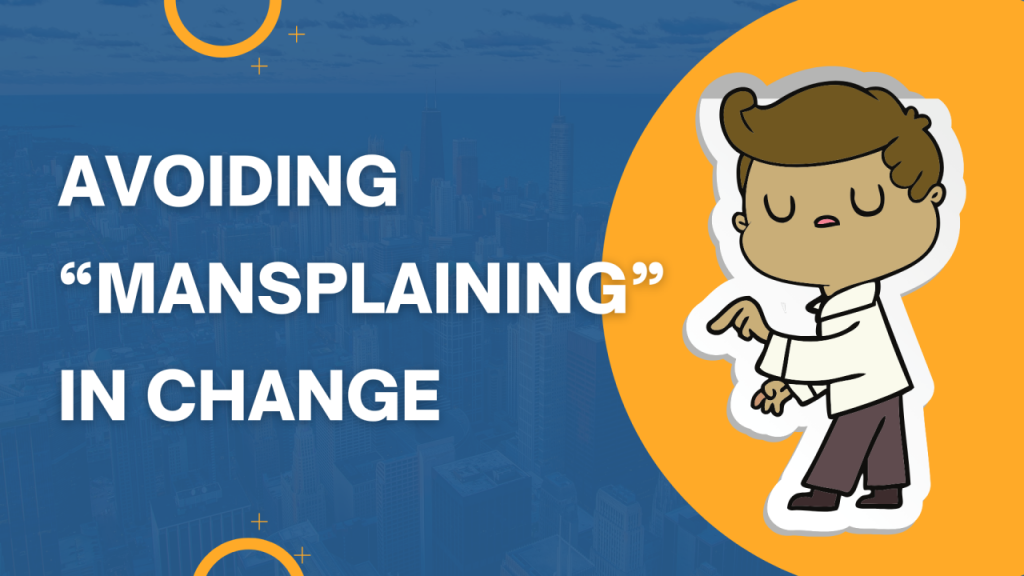
Many organizational changes originate from the ideas of senior leaders. So far, so good. But let’s be honest: more often than not, these leaders tend to be senior men with visions of greater efficiency and innovation. With this particular group comes a particular trap for change initiatives — ‘mansplaining.’ Falling into this trap not only risks diminishing the input of diverse team members but also threatens the overall success of the change by fostering resistance rather than collaboration.
The term ‘mansplaining’ isn’t just a buzzword from social media (such as the case of an amazing female cyclist who last week set a new world record for the “Everest Challenge” – just for the first male commentator to explain that her saddle height wasn’t correct). It’s a real issue in many modern workplaces.
Defined as when a man—or indeed a woman—provides an unsolicited explanation in a condescending, overconfident, or overly simplistic manner, mansplaining can deeply affect workplace dynamics.
While not always intentional, it can isolate individuals, making them feel unheard, overlooked, and inferior. Such interactions undermine professional respect and equity, affecting job satisfaction, confidence, and engagement. Though predominantly observed from men, women can also engage in this behavior, making it crucial for everyone to be vigilant against it.
When a change initiative suffers from mansplaining, it risks alienating key stakeholders and breeding resistance. This occurs when the change itself is “offered” in unsolicited, overly simplistic explanations without inviting input or recognizing the expertise within the team. Such interactions can diminish the perceived value of diverse contributions, leaving staff—particularly those not in leadership positions—feeling overlooked and undervalued. This not only decreases engagement and satisfaction but also undermines the effectiveness of the change process itself.
Of course, not every change is “invited” or can even be positioned this way. But there are a few actions you can take to embrace more inclusive and respectful communication strategies:
- Inclusive Planning Sessions: Start with inclusive planning sessions that involve people from various levels within the organization. Bringing diverse perspectives into the initial planning stages ensures the strategy is well-rounded and considers multiple facets of the organization’s operations and culture.
- Continuous Feedback Mechanisms: Establish mechanisms that encourage ongoing feedback throughout the implementation process. This should include safe spaces for honest feedback and regular check-ins to gauge how the change is being perceived across the organization.
- Leadership Training on Inclusivity: Provide targeted training for leaders on inclusive communication and active listening. This training should help them understand the importance of valuing all contributions equally and avoiding patronizing tones.
- Work with your Leaders actively: As a change leader, you want to be very honest with your sponsors and senior leaders. If you see patterns (such as mansplaining) in their behavior and communication, tell them and help them work on it.
Consider the rollout of a new IT system intended to streamline operations. Instead of this decision being confined to the C-suite, a diverse team is assembled, including not just IT and HR, but also representatives from other departments who will be regular system users. Through a series of workshops, these representatives share their insights, leading to adjustments that make the system more user-friendly and better tailored to actual needs. While the initiative’s overall aim remains the same – we improve adoption and efficiency – such an approach improves the system’s functionality, enhances buy-in and reduces resistance as users see their input reflected in the final product. As the change leader, you avoid the trap of an invasive, mansplaining-like perception of the initiative.
To transform leadership vision into effective change, organizations must ensure that their approach is inclusive and respects the voices of all employees. By avoiding the trap of ‘mansplaining’ and fostering a culture of collaboration and respect, change initiatives can achieve their goals with greater buy-in and less resistance. This shift from a top-down to a more inclusive approach can significantly alter the dynamics and outcomes of organizational change.
How have you seen mansplaining in the way your senior leaders run and communicate change initiatives? What was the effect? And what do you do to create a more inclusive approach to change?
#ChangeManagement #InclusiveLeadership #OrganizationalCulture #LeadershipDevelopment
This is a copy of the same post on my LinkedIn blog. To comment and join the discussion on this topic switch to LinkedIn. Follow me for regular updates and blog articles: https://www.linkedin.com/in/drnilskoenig/
